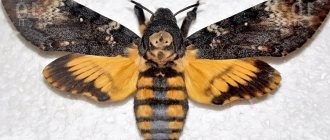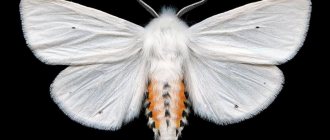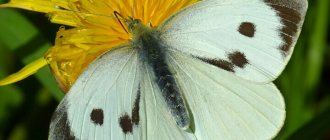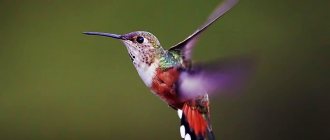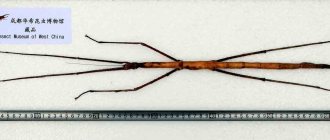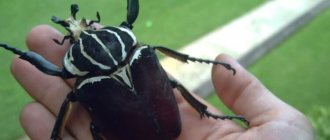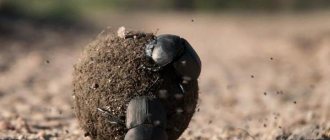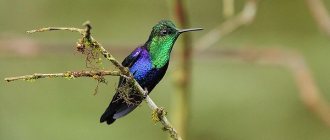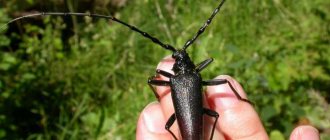Hawkmoth is a butterfly that looks like a hummingbird. She seems to be hovering over the flowers, quickly moving her wings. The colors of the representatives of this family are so diverse and original that it may be difficult to immediately guess which insect is in front of you. One of the main distinguishing features of the hawk moth is its long proboscis, which most often exceeds the size of the insect’s body. A video of the development of the caterpillar will be at the end of the article.
This unusually colored butterfly is a frequent hero of horror films and books. Why do superstitious people feel real trepidation at the sight of a small insect, and should summer residents who discover a hawkmoth pupa fear for their harvest?
In total, about 1,200 species of such butterflies are known, some of which are listed in the Red Book . In Russia you can see 50 species. How to understand that this is a hawk moth in front of you? Should you be afraid for the harvest if you find an uninvited guest at your summer cottage?
Description and appearance
The hawk moth butterfly is usually large or medium in size. Its body with a long proboscis of the Lepidoptera order has a cone shape at the end and is pointed, its wings are elongated and reach a span of 30 to 175 mm. The apices of the long antennae are pointed and hook-shaped. The eyes are round in shape and covered with a tuft of long scales. The proboscis is significantly longer than the body - it can be several times larger in size, but in some species it is short.
The leader in proboscis length among all insects is the butterfly Amphimoea walkeri. The proboscis of this South American species is sometimes 4 times larger than the body and measures 28 centimeters.
The hawk moth hovers over the flower.
The labial palps are curved upward. They are covered with scales on the outside, but there is no such covering on the inside. On the paws you can see short spines arranged in several rows. The abdomen has scales that gather at the end in the shape of a brush or tassel. The length of the hind wings is one and a half times greater than their width, and even in the photo a significant bevel towards the rear edge is visible to the naked eye.
Hawkmoth eggs are oval and measure approximately 1.5 by 1.2 mm. The color is usually pastel: it can be pale green or blue. The eggs are left on food plants, and the butterflies choose the underside of the leaves.
The hawkmoth caterpillar is distinguished by its large size, five pairs of legs and bright coloring - it is decorated with oblique stripes and spots resembling eyes, and individual hairs can be seen on the surface. Its length is initially up to 12 mm, while caterpillars of the fourth instar can grow significantly and be from 40 to 55 mm. Their weight is approximately 4 g.
Hawkmoths are real gourmets - they usually feed on either just one type of plant, or several, but closely related ones . You can see caterpillars both on trees and shrubs, most often in the dark - they are active in the evening and at night. However, some species are awake during the day.
The hawk moth pupa is distinguished by a characteristic elevation at the rear end, which is shaped like a horn. It is smooth and shiny. Weight varies from 7 to 12 g, color in the first hours after pupation ranges from yellow to cream, sometimes with a green tint, and later turns red. The pupal stage lasts about 30 days.
In the caterpillar stage
What does the hawk moth eat? Some species are pests that can cause harm to broad-leaved and coniferous trees in forests, and to stone fruit and fruit crops in gardens . But don't worry. The hawk moth caterpillar, although not beneficial, will not cause serious damage to the crop, and it is not worth fighting it.
This insect, similar to a hummingbird, is heat-loving. Most species are active migrants. The habitat is wide. Butterflies often move to other territories that are located north of the places where they were born. At the same time, hawk moths can easily overcome real obstacles on the way - for example, mountains that rise 3500 meters above sea level .
What do caterpillars look like?
The hawk moth caterpillar can be identified even without a photo. These are large, often very bright larvae. Covered with very little hair. The presence of a horn is characteristic, but not all species have it. The color can be pink, white, black, green. There may be oblique stripes and “eyes”.
The hawk moth has quite large caterpillars
There are also differences between each type of hawkmoth:
- The wine hawk moth caterpillar has a pair of large “eyes”; the larva is able to bend, lift the part of the body with the “eyes” and inflate it, which makes the spots even more frightening.
- The triangularis caterpillar is covered with yellow hairs. The larvae's legs have a pattern that makes them look like a reptile's eye.
- The larva of the poplar hawkmoth is green, with a yellow pattern and oblique stripes.
- The lilac in its larval stage is also bright green with pink stripes. In the absence of movement, it resembles a plant leaf, while the horn imitates the stem of the leaf.
- The Euphorbia Hawkmoth caterpillar has black rings on a yellow background. But the legs and head are bright red.
- The larva of the bedstraw hawkmoth is almost black, with yellow spots on the sides of the larva.
Features and lifestyle
How to understand that this is a hawk moth butterfly? Pay attention to its features:
- Adults can be up to 11 cm in length, with a proboscis up to 10 cm.
- The speed of movement of the hawk moth is up to 50 km per hour.
- Butterflies have fantastic colors.
- The hawk moth larva reaches 12.5 cm.
- The horn comes in different colors depending on the type of insect.
- Before the pupa turns into a butterfly, a color change occurs.
- Hawkmoth looks like an alien creature - his “outfit” can be so unusual.
An inhabitant of Russian latitudes, who is often mistaken for an alien
Of course, at the very beginning I would like to talk about those types of large green caterpillars with horns that live in our country. The most common larva of the hawk moth and all its subspecies. For example, linden hawk moth. Its larva is a fairly long caterpillar. Sometimes it reaches 10 cm in length
Its coloring, unlike other caterpillars with horns, is quite calm and not particularly eye-catching. Most often, this insect is light beige or light brown in color with a white belly, on which there are horny growths, which are nothing more than the rudiments of the insect’s legs
They are quite hard and tenacious to the touch; thanks to these properties, the caterpillar can easily move along tree trunks. In rare cases, linden hawk moth larvae can be bright green or black with brown speckles. No matter what color the caterpillars are, they always have a sharp, hard spike on their tail, which many take for a horn, confusing the insect’s head with its tail.
Should summer residents be afraid of hawk moth?
The basis of the diet of this species is fragrant nectar . Therefore, in areas where there are many flowers and shrubs, they are more common. You can see how the hawk moth seems to hover over a flower in a flower bed. They appear in the garden extremely rarely - usually isolated cases are recorded. The population size changes significantly every year and largely depends on weather conditions. So in cold years there are significantly fewer hawk moths, and in warm years the number of insects increases sharply.
The caterpillars do not cause serious damage to plantings - they feed on young leaves, but not on a significant scale, so the plants quickly recover. The accumulation of such insects is very rare. Therefore, if you see a caterpillar, then there is no need to worry about the harvest; it is better to just carefully move it from your plot to the meadow, because this insect is listed in the Red Book.
Eating
Since ancient times, it has been believed that the hawkmoth moth is a harbinger of serious troubles. Most likely, the reason for such superstitious fears and hostility lies in the appearance of the butterfly. On the back of some species you can see an ominous pattern - as if a skull and crossbones are depicted on the body. To see what a hawkmoth looks like, you can search for photos using the query “hawkmoth moth photo.” The second reason, which has given rise to a lot of speculation, is the unpleasant squeak of an insect.
Reproduction
The breeding season of insects occurs at the end of May, but in tropical regions it can be year-round or have 2 - 3 generations.
At the beginning of April in the temperate climate zone, after wintering, butterflies actively begin their mating procession. After some time, the female butterfly can lay more than 150 yellow eggs on the opposite part of the nettle leaf. After ten or fifteen days, the caterpillars hatch from them.
Cabbage butterfly caterpillars are dark or black in color and have elongated light yellow stripes on the body and back. Once hatched, they create webs on plant trunks.
They try to stay in groups and feed on the leaves of stinging nettle or stinging nettle. In thirty days, the caterpillar can grow up to two centimeters.
The first brood of caterpillars develops from May to June, the second - from July to August. In order to pupate, the caterpillar looks for a secluded place, but can pupate directly on the stem of the host plant.
Sometimes, the pupa can be seen hanging on a fence or building structures. She attaches the base of her body with her head down and waits until the final two-week period of development begins.
This species of butterfly flies from June until late autumn, after which it looks for places to hibernate. Most often these places are:
- Attics of houses;
- Window frames (rare, but such cases do occur);
- Hollow trees;
- Rock crevices and other places;
Waking up in early spring, they have time to mate and lay offspring, then they moderate.
Hawkmoths in culture
For superstitious people, meeting a hawk moth is a frightening event. A butterfly called "death's head" has become the heroine of creepy legends and stories. This insect has been blamed for disease, death and even war. Some beliefs are still alive - the Mexicans believe that if a scale from a hawk moth's wing accidentally gets into the eye, you can even go blind.
Mentions of the scary butterfly can be found in books and films. So in the film “The Silence of the Lambs” by Jonathan Demme, a maniac puts a hawkmoth pupa into his victims’ mouths. In the novel on which the film was based, a different species was chosen - Acherontia styx, but in the film we see the death's head hawkmoth.
Edgar Poe mentions this butterfly in the story “The Sphinx” - where the insect was crawling along the web on the window. Alexander Belyaev refers to the same creepy image in the story “The Death's Head”.
Van Gogh called one of his works “Death's Head Hawkmoth.” However, he mistakenly depicted another butterfly, called the Pear-Eyed Peacock. A new name was given to the painting at the Artist's Museum in Amsterdam, renaming it “Imperial Night Butterfly”.
Goldtail
caterpillar (Euproctis chrysorrhoea)
(
goldworm
or
golden silkworm
) also has poisonous hairs! Distributed throughout almost all of Europe, including Russia. Loves orchards and parks, where it is most often found! It is dangerous because, if touched, it can cause various inflammatory processes, rashes or scars on the skin. Breathing problems are also possible, and if hairs get into the eyes, conjunctivitis can occur.
Goldentail caterpillar
How long does this butterfly live?
The hawk moth insect does not live long. Its life cycle consists of four phases. First, the female must lay an egg, from which a larva emerges after 2-4 days. The caterpillar turns into a pupa, and later an adult is born. To attract the attention of the male, a special pheromone is released. After mating, which lasts several hours, the butterfly lays eggs on the plants.
The lifespan of these insects varies depending on the species:
- the tobacco hawk moth lives for about a month;
- some species live only a few days and die after new eggs are laid. At the same time, they feed on the reserves that were made earlier. The full classification of butterflies is here.
Swallowtail
Swallowtail is another insect named after a mythological hero. This time it is an ancient Greek doctor. About 40 subspecies of swallowtails are known. All of them are very colorful both at the imago stage and during the development of larvae. They are distributed throughout the Northern Hemisphere. Found in North Africa, North America, throughout Europe, except Ireland. In mountainous areas they can rise to heights from 2 to 4.5 kilometers.
Swallowtail caterpillars are born twice a season: in May and August, but they remain in the larval state for only a month. As they grow older, their appearance changes greatly. At first they are black with red dots and a white spot on the back. Over time, the color becomes light green, and black stripes and red dots are placed on each segment; white color is present only on the limbs. They also have a hidden osmeterium that is bright orange in color.
Today we will continue this topic and talk about the most dangerous caterpillars that can be found in Russia.
I immediately hasten to reassure you a little, in our country there are no deadly poisonous caterpillars, such as, for example, Lonomia obliqua, and we are not in danger of death from their poison
However, in our homeland there are caterpillars that should be treated with at least caution! After all, their poison-soaked hairs can cause quite a lot of trouble! The video version of the article can be seen here (the text is continued below):
The video version of the article can be seen here (the text is continued below):
Hawk Moth Breeding
Hawkmoth butterflies of most species are easily bred in captivity. Usually an aquarium is installed at home, with branches of deciduous trees placed inside it. The caterpillars are planted on them. Soil and pebbles are placed at the bottom. In winter, the bottom of the aquarium is covered with sphagnum or wet sawdust. For hatching, the aquarium must be illuminated for at least 14 hours a day. The required humidity is maintained using a spray bottle. Read more about what a Butterfly Farm is.
RED TAIL
Redtail (Calliteara pudibunda)
or, as it is also called
the shy paw
, can have a different color of “fur” (lemon, pink, brown, gray), but it always has a constant reddish tail in the back. The caterpillar is not capable of causing any serious damage, however, you should still not touch it with your hands, unless, of course, you want to get an allergic reaction in the form of a rash! Prefers oak forests and is found throughout Eurasia, except the far north.
Redtail caterpillar
SURVIVE.RU
Post Views:
15 340
Types of hawk moths
Wine hawkmoth (also called "grape hawkmoth" or "rose hawkmoth") is found on grapevines. This species is distinguished by its bright color, large size and sharp spine.
The lilac hawk moth is one of the largest butterflies that adorns the hawk moth family. Its wingspan ranges from 90 to 120 mm . The hind wings are colored pink, and rings can be seen on the abdomen, some of which are also pink, while others are brown. The lilac hawk moth differs from other species in its proboscis - its length is approximately the same as the insect’s body. The caterpillar can be of two colors - green or purple.
Hawkmoth is a hummingbird of the middle zone. Indeed, as you can see from the photo, it won’t be difficult to find common features between a butterfly and a bird. It's a joke of nature - hummingbirds are the tiniest birds, their weight is usually no more than 2 g, and hawk moths are the leaders among butterflies in size. While feeding, insects do not sit on flowers, but seem to hover over them, quickly flapping their wings. It seems that a tiny bird is hovering over the bud. In central Russia, one of the most common species is the bedstraw hawk moth.
The linden hawk moth is easily recognizable due to its front wings with jagged edges, the span of which can be from 60 to 80 mm. And here we have photographs of the largest butterflies in the world. Color ranges from olive green to rust with irregular dark spots. The hind wings are yellow ocher. The caterpillar of this species is green with red and yellow stripes. You can see it in summer on birch, alder and linden trees.
The moth hawk moth is not protected from the dangers that await it in its natural habitat everywhere. For example, wasps and moths can lay eggs on the surface of the body of a butterfly or pupa. The emerging parasites use the internal organs of the hawk moth as food. The night hawk moth can also be killed by chemical insecticides used by humans, as well as be eaten by birds. Therefore, the insect is forced to defend itself, sometimes using unusual methods. For example, a hawkmoth larva can easily feign death during a bird attack. By the way, here is a list of all moths.
Sometimes caterpillars take threatening poses to scare away enemies - the front part of the body rises menacingly, the insect freezes in this pose. In case of danger, the hawkmoth butterfly can strongly inflate its abdomen.
General information
Hawkmoths do not have a specific type of activity. Some varieties of hawk moths prefer to be active at night, while others prefer to be active in the morning and during the day.
This type of moth is quite large: the wingspan can reach 150 millimeters, and the body is about 100 millimeters long.
Although from a number of moths the dwarf hawk moth is distinguished, the wingspan of which reaches only three centimeters. Due to their heavy weight, moths cannot stay on the flower petals, which is why they prefer to feed by fluttering over the flower.
Interesting facts about hawk moths
Hawk Moth is distinguished not only by its bright and memorable coloring. Some facts about this insect are amazing:
- The death's head butterfly is a real intruder in the world of insects. The hawk moth robs the bees - it flies up to the hive and begins to buzz characteristically, then pierces the honeycomb with its proboscis and feasts on honey. But sometimes the bees understand the trick, pounce on the robber, bite him to death and then mummify him in the hive.
- Another feature of the species is that in times of danger it begins to squeak loudly and desperately.
- In a minute, an insect can cover a distance that is 25 thousand times greater than its body.
- In the Middle Ages, the lilac hawk moth was terribly feared because it was considered a harbinger of death.
- From Latin the name of the wine hawkmoth (“porcellus”) is translated as “piglet”. From a distance, the insect appears to be completely pink.
PINE WALKING SILKWORTH
Pine silkworm (Thaumetopoea pinivora)
- earned its name thanks to its love for collective travel, and it also loves pine needles, which it feeds on! In June, the silkworm moves mainly along pine branches and needles, huddling in groups when it gets colder, but towards the end of July - beginning of August it goes on a journey. Lined up with their relatives in long rows, literally marching along the earth, asphalt and other surfaces to get to a suitable, sandy place. After which they pupate by burying themselves in the sand.
Looking at the lifestyle of the traveling pine silkworm, it becomes clear that it can most likely be found among young pines, with less sandy soil. As the caterpillars grow older, they become more dangerous, and the caterpillars' outfit also changes. The hairs from the small fluff develop into a lush outfit, which, however, a completely mature caterpillar grinds, as it were, into special depressions in the body. As a result, dust from hairs is formed, causing itching and burning when it comes into contact with the skin and mucous membranes of a person! It’s not like touching here, it’s not recommended to be near such caterpillars!!! An allergic reaction from flying hairs invisible to the eye can manifest differently in different people! Usually, inflammatory processes are observed in the attacked areas of the skin; it becomes covered with red blisters that itch irresistibly! When it comes into contact with the face, the picture is most often accompanied by swelling, and the eyes may become swollen and closed. The inflammatory processes themselves can last for several weeks! If you are unlucky enough to develop an allergic reaction, you should consult a doctor immediately!
Pine silkworm caterpillar
Hawk Moth Guard
The diversity of hawkmoth species is amazing, but the population is declining. This is influenced by a number of factors:
- the number of birds that feed on caterpillars is increasing;
- bushes are cut down and grass is burned;
- feed crops are treated with substances that are toxic to butterflies.
In Russia, the most favorable conditions for hawk moths are in the Transcaucasus - thanks to the mild climate, the pupae endure winter more easily. Hawkmoths were included in the Red Book back in 1984.
In some regions where butterflies are critically endangered, insecticide use is being reduced. In addition, the number of plants burned is limited, because they may contain hawkmoth pupae. These simple but effective measures can save rare species and help increase the number of beautiful species.
Area
All species of the family are heat-loving insects, but many species are active migrants and fly into territories that lie significantly north of their breeding grounds. They are able to fly across seas and mountain ranges (over 3500 m above sea level).
- Saber-toothed tiger
- 50 facts about kangaroos
- long eared hedgehog
- Cross spider
- Reptiles
- 72 facts about plants
Types of hawk moths:
- euphorbia;
- wine;
- pine;
- hawkmoth "death's head";
- ocular;
- oleander;
- bindweed;
- lilac;
- proboscis hawk moth and others.
There are about 1,000 species of “northern hummingbirds” on the planet. Some species make long-distance flights, migrate from one end of the country to another, or cover distances between continents.
Reasons for appearance
Hummingbird butterflies are attracted to the garden by beautiful flowers with fragrant nectar: the insects feed on the sweet mass. The greater the variety of trees, shrubs, berries and vegetables a caring owner has, the higher the food supply for caterpillars and adults. The wine hawk moth lives in vineyards. Large butterflies often fly into the apiary.
Caterpillars eat greens. Large creatures actively gnaw the leaves of viburnum, lilac, willow, potatoes, dope, and jasmine.
How to get rid of red ants in an apartment? Learn methods of control using chemicals and folk remedies.
Effective methods for exterminating bedbugs in residential areas are described on this page.
Go here and read about how to get rid of fleas on your dog.
Taste preferences
If you are lucky enough to see a butterfly in “haute couture camouflage” in the evening in a warm climate, then it may be an oleander hawk moth. What does this beauty eat? Like most hawk moths, the oleander species has food selectivity.
The caterpillar's diet is based on periwinkle and oleander. Despite the fact that both of these plants are poisonous, the caterpillar itself does not accumulate dangerous substances, which makes it completely defenseless. In some regions the insect may feed on grape leaves, but this occurs infrequently.
